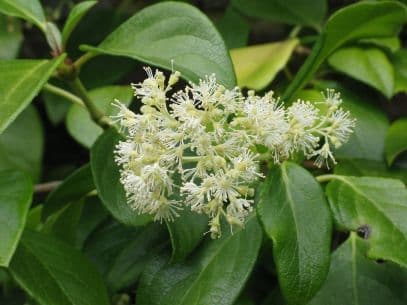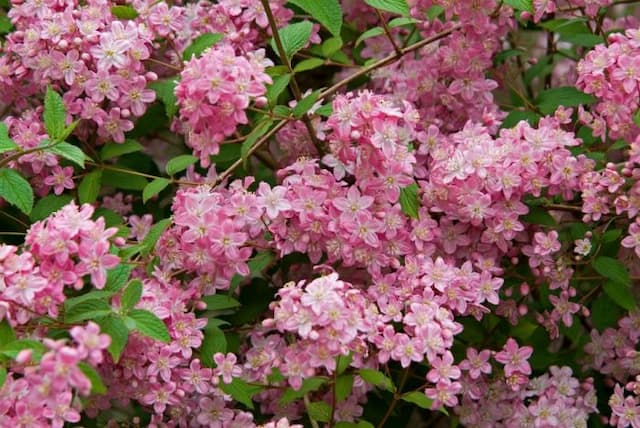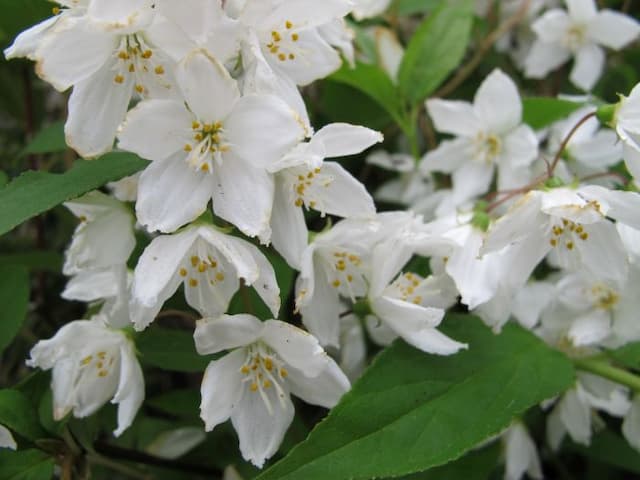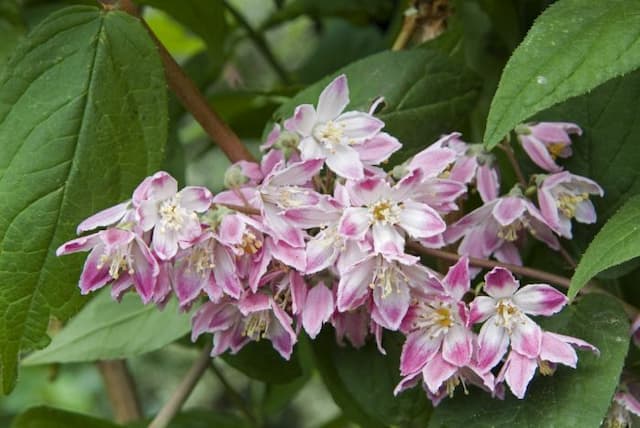Lacecap Hydrangea Hydrangea macrophylla 'Veitchii' (L)

ABOUT
The Hydrangea macrophylla 'Veitchii' commonly known as Lacecap Hydrangea, features distinctive flowers with a unique two-part arrangement that resembles the complexity of a vintage lace cap. The blossoms comprise a flat or slightly convex disk fringed by larger, ornate florets, creating the impression of a flower cap surrounded by a lacy fringe. These decorative florets are typically a soft pink or blue, their hue influenced by the soil's acidity. In more acidic soils, the flower colors lean towards a rich blue, while in neutral or alkaline soils, they present in delicate shades of pink. The leaves of the Lacecap Hydrangea add to its overall charm, being broad, ovate, and lush green, with a slightly toothed margin. Their substantial size and lushness contribute to the plant's dense, bushy appearance, making it a favorite among gardeners for its full and robust foliage that adds texture and a verdant backdrop to the garden throughout the growing season. Bearing such an enchanting ensemble of flowers and foliage, the Lacecap Hydrangea is often used in garden landscapes to create a romantic, cottage garden feel or as a feature plant thanks to its showy floral display that adds visual interest and draws in observers for a closer look.
About this plant
 Names
NamesFamily
Hydrangeaceae
Synonyms
Veitch's Hydrangea, Lacecap Hydrangea
Common names
Hydrangea macrophylla var. acuminata (L.) Makino, Hydrangea macrophylla subsp. acuminata (Sm.) Makino, Hydrangea macrophylla var. normalis (Britton) Rehder, Hydrangea serrata subsp. acuminata (Sm.) H.Hara, Hydrangea serrata var. acuminata (Sm.) Makino.
 Toxicity
ToxicityTo humans
Hydrangea, including the 'Veitchii' variety, contains compounds that can be toxic when ingested by humans. These include cyanogenic glycosides, which can release cyanide in the body. If parts of the hydrangea are consumed, it may lead to symptoms such as nausea, vomiting, stomach pain, diarrhea, and in some cases, more severe symptoms like dizziness or difficulty breathing due to cyanide toxicity. It is important to be cautious and avoid consuming any part of the hydrangea plant.
To pets
Hydrangea, including the 'Veitchii' variety, is also toxic to pets like cats and dogs. It contains compounds such as cyanogenic glycosides that can release cyanide into the body. Ingesting parts of a hydrangea can cause symptoms in pets such as vomiting, diarrhea, lethargy, and depression. In more severe cases, ingestion may lead to increased heart rate, heavy panting, an elevated body temperature, and in extreme cases, seizure or coma. It's crucial to prevent pets from accessing and potentially ingesting any part of a hydrangea plant.
 Characteristics
CharacteristicsLife cycle
Perennials
Foliage type
Deciduous
Color of leaves
Green
Flower color
Varies
Height
4-6 feet (1.2-1.8 meters)
Spread
4-6 feet (1.2-1.8 meters)
Plant type
Shrub
Hardiness zones
6
Native area
Japan
Benefits
 General Benefits
General Benefits- Enhances Aesthetics: Adds visual interest to gardens with its large colorful flower heads that can range from blue, pink to white depending on soil pH.
- Attracts Pollinators: Flowers provide a food source for bees and butterflies, fostering a healthy ecosystem.
- Seasonal Interest: Offers a long blooming season from early summer to fall, providing continual interest throughout the gardening season.
- Diverse Landscaping Uses: Can be utilized in a variety of landscape designs including borders, hedges, or as a focal point in garden beds.
- Cultural Significance: Often used in weddings and celebrations, the blooms symbolize gratitude, grace, and beauty.
- Can Tolerate Shade: Suitable for shadier spots where other sun-loving flowering shrubs might not thrive.
 Medical Properties
Medical PropertiesThis plant is not used for medical purposes.
 Air-purifying Qualities
Air-purifying QualitiesThis plant is not specifically known for air purifying qualities.
 Other Uses
Other Uses- Hydrangea macrophylla 'Veitchii', commonly known as the Lacecap Hydrangea, can be used as a natural dye, with its flowers providing varying shades of blue, pink, or purple depending on the pH of the soil they were grown in.
- Lacecap Hydrangea leaves can be used in compost as they decompose well and enhance the nutrient content, contributing to a rich, organic compost mix.
- Pressed Lacecap Hydrangea flowers are often used in craft projects, such as creating greeting cards or bookmarks, due to their intricate and colorful patterns.
- The wood from Lacecap Hydrangea is sometimes utilized in small woodworking projects because when dried, it can become quite hard and is suitable for creating ornamental pieces.
- Lacecap Hydrangea can be planted as part of a rain garden design that helps to collect and filter runoff water, as they can tolerate and thrive in moist soil conditions.
- The large leaves of the Lacecap Hydrangea can be used to wrap small delicate items for short-term, natural packaging material.
- In flower arrangements, dried Lacecap Hydrangea blooms add lasting beauty, holding their shape and color well after being dehydrated.
- Gardeners often use Lacecap Hydrangea as a natural method to gauge soil pH, as the color change in the blooms indicates whether the soil is acidic or alkaline without using a test kit.
- The expansive, bushy growth of Lacecap Hydrangea can provide shelter for small wildlife in the garden, creating a microhabitat beneficial to insects and birds.
- Lacecap Hydrangea is sometimes featured in photography and painting classes as a subject for art due to its unique and distinctive flower patterns.
Interesting Facts
 Feng Shui
Feng ShuiThe Hydrangea is not used in Feng Shui practice.
 Zodiac Sign Compitability
Zodiac Sign CompitabilityThe Hydrangea is not used in astrology practice.
 Plant Symbolism
Plant Symbolism- Heartfelt Emotions: Hydrangeas are often associated with deep emotional expression. The lushness of the 'Veitchii' blooms can symbolize the fullness of one's feelings.
- Gratitude: Gifting hydrangeas can be a way of saying thank you, as their opulent flower heads can represent abundance and generosity.
- Understanding: The diversity of colors in the 'Veitchii' bloom can symbolize a variety of perspectives, aligning with the symbolism of comprehension and enlightenment.
- Frivolity: Some interpret hydrangeas as being representative of playfulness and light-heartedness because of their large, round flower clusters.
- Vanity: In some contexts, the Hydrangea macrophylla 'Veitchii' may reflect vanity or boastfulness due to its showy appearance and tendency to dominate a garden space.
- Perseverance: This particular hydrangea is known for its hardiness, often symbolizing the perseverance needed to withstand various conditions.
 Water
WaterLacecap hydrangeas, such as the Hydrangea macrophylla 'Veitchii', require consistent moisture and prefer well-draining soil. Water the plant deeply once a week, providing about 1 gallon of water for each shrub sized plant; increase the frequency to twice a week during extremely hot or dry periods. Avoid overhead watering to prevent leaf spot and other fungal diseases. In cooler climates or during the rainy season, you can reduce the frequency but ensure the soil remains moist, not waterlogged. It's crucial not to let the soil dry out completely, as this can lead to wilting and damage the blooms.
 Light
LightThe Lacecap hydrangea thrives in partial shade, with morning sun and afternoon shade being ideal. The best spot for it would be an area that receives dappled sunlight throughout the day or bright, indirect light. Avoid exposing the plant to intense, direct afternoon sun, as this can scorch the leaves and flowers.
 Temperature
TemperatureLacecap hydrangeas prefer temperatures ranging between 65 to 75 degrees Fahrenheit during the day and slightly cooler at night. They can survive minimum temperatures of around 50 degrees Fahrenheit but should be protected from frost. The ideal growing conditions are moderate temperature environments without extreme heat or cold, as they can be sensitive to temperatures above 80 degrees Fahrenheit or below the mentioned minimum.
 Pruning
PruningPruning Lacecap hydrangeas is necessary to remove dead wood and encourage new growth and better blooms. The best time to prune is after flowering, typically in late summer or early fall. Avoid heavy pruning in spring, as this is when the plant sets buds for the next season's flowers. To maintain shape and vigor, cut away old, non-productive stems, making room for new shoots.
 Cleaning
CleaningAs needed
 Soil
SoilLacecap hydrangeas thrive in rich, porous, moist soil with good drainage. A blend of 50% peat moss or compost and 50% garden soil or potting mix creates ideal conditions. They prefer a soil pH of around 5.5 for blue flowers and 6.5 for pink, which can be modified with soil amendments.
 Repotting
RepottingLacecap hydrangeas should be repotted every 2-3 years or when they outgrow their current pot. Spring is the best time for repotting to allow the plant to establish itself during the growing season.
 Humidity & Misting
Humidity & MistingLacecap hydrangeas flourish in environments with moderate to high humidity. Aim for a humidity level of about 60-70% for optimal growth; misting the leaves can help maintain the required humidity.
 Suitable locations
Suitable locationsIndoor
Keep in bright, indirect light and maintain high humidity.
Outdoor
Plant in partial shade, shelter from strong winds, keep soil moist.
Hardiness zone
6-9 USDA
 Life cycle
Life cycleHydrangea macrophylla 'Veitchii', commonly known as lacecap hydrangea, begins its life cycle as a dormant seed, which, when sown in fertile, well-draining soil and exposed to the right conditions, germinates and emerges as a seedling. It then enters a vegetative stage, where it develops an extensive root system and foliage through photosynthesis during spring and summer. As it matures, it starts to produce distinctive lacecap flowers composed of tiny, fertile flowers surrounded by larger, infertile flowers, typically in early to mid-summer. After pollination, these flowers give way to seed capsules that mature by late summer or fall, thus completing the reproductive phase. The plant enters dormancy during the colder months, with foliage dying back in regions with cold winters, and it conserves energy for the next growth cycle. With proper care, including pruning to encourage new growth, the hydrangea's perennial nature ensures this cycle repeats annually for many years.
 Propogation
PropogationPropogation time
Spring-Early Summer
The most popular method of propagating Hydrangea macrophylla 'Veitchii', commonly known as lacecap hydrangea, is through stem cuttings. This is typically done in late spring or early summer when the plant is actively growing. A healthy, non-flowering shoot is selected, and a section about 5 to 6 inches (roughly 12.5 to 15 centimeters) long is cut just below a leaf node. The lower leaves are removed, and the cut end is dipped in rooting hormone to encourage root development. The cutting is then planted in a pot filled with a mixture of peat and perlite, leaving the top two sets of leaves above the soil surface. The pot is then placed in a warm, brightly lit area but out of direct sunlight to avoid scorching, and is kept consistently moist until roots have formed and new growth is evident, indicating successful propagation.






![Rose deutzia [Yuki Cherry Blossom]](/_next/image?url=https%3A%2F%2Fplants-admin.emdemapps.com%2Fimages%2Fplants%2F%2Fimages%2F604b6510a383a.png&w=640&q=75)
![Hydrangea [Hot Chocolate]](/_next/image?url=https%3A%2F%2Fplants-admin.emdemapps.com%2Fimages%2Fplants%2F%2Fimages%2F604b5a066e3bd.png&w=640&q=75)
![Hydrangea [Blackberry Pie]](/_next/image?url=https%3A%2F%2Fplants-admin.emdemapps.com%2Fimages%2Fplants%2F%2Fimages%2F604b56e2abc1d.png&w=640&q=75)
